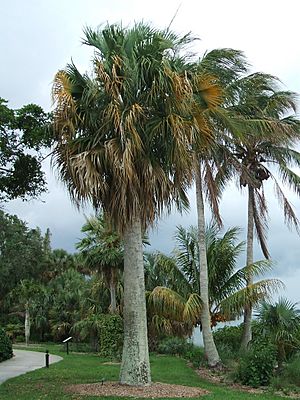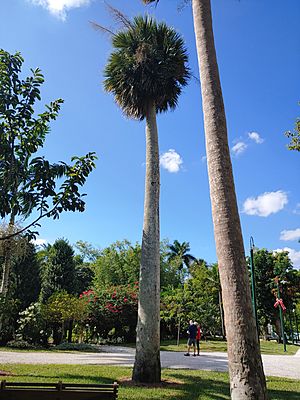Puerto Rico palmetto facts for kids
The Puerto Rico palmetto (scientific name: Sabal causiarum) is a special type of palm. People also call it the Puerto Rican hat palm. This palm tree grows naturally in places like Hispaniola, Puerto Rico, and the Virgin Islands. Its name comes from how its leaves are used. People have traditionally made straw hats from them!
Quick facts for kids Puerto Rico palmetto |
|
|---|---|
 |
|
| At Marie Selby Botanical Gardens, Sarasota, Florida | |
| Conservation status | |
| Scientific classification | |
| Genus: |
Sabal
|
| Species: |
causiarum
|
| Synonyms | |
|
Inodes causiarum O.F.Cook |
|
Contents
What it Looks Like
The Puerto Rico palmetto is a fan palm. This means its leaves spread out like a fan. It has a single, very strong trunk. This trunk can grow up to 10 metres (33 ft) (about 33 feet) tall. It can also be quite wide, from 35 centimetres (14 in) to 70 centimetres (28 in) (about 14 to 28 inches) across.
Each palm tree usually has 20 to 30 leaves. Each leaf has many smaller parts, called leaflets. There are usually 60 to 120 leaflets on one leaf!
The palm produces flowers on special branches called inflorescences. These branches are longer than the leaves. They can arch or hang down. After the flowers, the tree grows round, black fruits. These fruits are small, about 0.7 centimetres (0.3 in) to 1.1 centimetres (0.4 in) (about 0.3 to 0.4 inches) wide. The size and shape of its fruit help tell it apart from a similar palm, Sabal domingensis.
How it Got its Name
The Puerto Rico palmetto belongs to a group of palms called Sabal. In 1901, an American botanist named Orator F. Cook first described this palm. He called it Inodes causiarum.
The word causiarum comes from Latin. It means "of hats." This is because people used the leaves to make hats. The Latin word causia referred to a wide-brimmed hat from ancient Macedonia.
Later, an Italian naturalist named Odoardo Beccari moved the palm to the Sabal group. He gave it the scientific name we use today: Sabal causiarum.
Over the years, other botanists described similar palms. These included Inodes glauca, Sabal haitensis, and Sabal questeliana. But scientists now believe all these names refer to the same palm: Sabal causiarum.
Some scientists think that Sabal causiarum, Sabal domingensis, and S. maritima might be very closely related. They could even be different forms of just one species.
Other Names for the Palm
In English, this palm is known as the hat palm, Puerto Rican hat palm, or Puerto Rico palmetto.
In Spanish, people call it different names depending on the country:
- In the Dominican Republic, it's called palma cana.
- In Puerto Rico, it has many names like palma de sombrero, yarey, palma de escoba, palma de abanico, or palma de cogollo.
Where it Grows
The Puerto Rico palmetto is found in a few places. It grows in the southwestern part of Haiti and the eastern part of the Dominican Republic. It also grows in Puerto Rico and on islands like Anegada and Guana Island in the British Virgin Islands.
It usually grows in low areas, from sea level up to about 100 metres (328 ft) (about 330 feet) above sea level. An American botanist named George Proctor also saw this palm on Saint Croix in the United States Virgin Islands.
How People Use It
The leaves of the Puerto Rico palmetto are very useful. As its names suggest, they are mainly used to make hats. In 1901, people in a village called Joyuda in Cabo Rojo made many hats from these leaves.
However, by the 1980s, the hat-making industry had become much smaller. Besides hats, the leaves are also used to make other things. People weave them into baskets, mats, and hammocks. Older leaves can even be used for thatch, which is a roof covering made from plant material.
Because of its large and impressive look, the Puerto Rico palmetto is also planted as an ornamental tree. You might see it in gardens or as a street tree in some areas.
See also
 In Spanish: Sabal causiarum para niños
In Spanish: Sabal causiarum para niños



